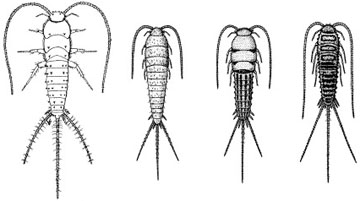Silverfish and firebrats (also called bristletails) belong to the insect order Thysanura. Three species of silverfish — Lepisma saccharina, Ctenolepisma longicaudata and Ctenolepisma quadriseriata — and one species of firebrat, Thermobia domestica, are the important house-dwelling bristletails in North America (Figure 1). Some of the differences between these species are shown in Table 1. All bristletails are carrot-shaped, somewhat flattened, and covered with grayish scales. They have long, slender antennae and three slender appendages at the rear of the body. They are wingless and do not fly. However, they move quickly, often stopping for short intervals and then rapidly moving on.
Table 1
Characteristics of house-dwelling silverfish and firebrats.
| Species | Size | Appearance | Preferences | Location in houses |
|---|---|---|---|---|
| Common silverfish Lepisma saccharina | 1/2 inch (1.5 centimeters) | Color uniform; silvery sheen Markings none | Temp 70-80 degrees F Moisture high humidity | Near moisture; basements, lower floors, crawl spaces, etc. |
| Gray silverfish Ctenolepisma longicaudata | 3/4 inch (2.0 centimeters) | Color uniform; gray Markings none | Temp 80-85 degrees F Moisture wide humidity range | Throughout; from basement to attic, closets, storage areas, kitchens, etc. |
| Four-lined silverfish Ctenolepisma quadriseriata | 1/2 inch (2.0 centimeters) | Color tannish-gray Markings four lines down back | Temp 80-85 degrees F Moisture wide humidity range | Throughout; from basement to attic, closets, storage areas, kitchens, etc. |
| Firebrat Thermobia domestica | 1/2 inch (1.5 centimeters) | Color mottled; gray Markings dark patches on back | Temp 100 degrees F Moisture moderate humidity | Warmer areas; boiler rooms, hot water heaters, ovens, attics, etc. |
 Figure 1
Figure 1
Silverfish and firebrats, typically 1/2 inch to 3/4 inch long, thrive in human dwellings, feeding on materials derived from plants.
Damage
Silverfish and firebrats feed and cause damage to a variety of materials but seem to prefer materials of plant origin that are high in carbohydrates and protein. They feed on glue in bookbindings or behind wallpaper, and on paper, paper sizing, cereal grain products and dried meat. They may also damage silk and some synthetic fabrics, but they usually avoid woolens.
Silverfish and firebrats prefer dark places and are most active at night. Most species are found outdoors in hidden locations, such as under tree bark and rocks, or in the nests of animals, but human dwellings provide a good environment for a few species. Inside the house, bristletails can be found almost anywhere, but they are most abundant in attics, basements, wall voids, hollow decorative beams, dark closets, bookshelves and storage rooms. They are often found in sinks, lavatories and bathtubs because they have fallen in and become trapped while seeking moisture.
Houses with wooden shingles seem to be particularly attractive to bristletails, which can enter the home from under these shingles. In addition, infestations can start when eggs, nymphs or adults are brought into a house on infested cardboard boxes, cartons, furniture or similar items.
Life history
Silverfish and firebrats are long-lived insects. Development time from egg to adult takes anywhere from three months to three years for silverfish, whereas firebrats complete development from egg to adult in about four months. Adult silverfish and firebrats may continue to live for up to three years. This equals a potential lifespan of about six years for silverfish and three to four years for firebrats. Adults continue to molt throughout the remainder of their lives.
Adults lay eggs in cracks and crevices near food sources. Depending on species, adults lay five to 50 eggs per clutch. These eggs hatch into nymphs, which look like small adults. They molt several times during the nymph and adult stages and have been observed to shed their skins more than 30 times a year. Development time from egg to adult varies between the four house-dwelling species and is summarized in Table 1. All stages have a similar diet.
Control
Prevention
Infestations usually start when infested materials are brought into the home. When possible, inspect and treat all boxes, furniture, cartons or other items that have been used or stored in infested areas. Caulking holes and cracks around windows and doors, which allow silverfish to enter from outside, will help prevent infestations. Reduce potential food sources by storing old books, papers, starched linens and cardboard boxes in sealed plastic containers.
Lowering the humidity and temperature in a house will also help control silverfish because they generally prefer high humidity and moderately high temperatures. Lowering the temperature in areas around hot water pipes, water heaters and boilers will reduce firebrat populations. Improved air circulation in these areas will usually lower temperatures slightly.
Chemical control
Chemical insecticide treatments are often necessary to eliminate established silverfish and firebrat infestations. Insecticides containing pyrethroids or boric acid are available over the counter in home and garden stores. Treat cracks and crevices around and behind baseboards, shelves, bookcases, closets and windows. Pay special attention to void spaces inside walls, decorative ceiling beams and curtain rods. In addition, basements and attics should be inspected and may need to be treated. When treating an attic, void spaces and large cracks, use an insecticide dust. Aerosol sprays work well on crawling insects, surface applications, and small cracks and crevices. Beware that aerosols applied to raw concrete are absorbed into the pores and rapidly lose their effect.
Warning on the use of chemicals
Before using any chemical, please read the label carefully for directions on application procedures, appropriate rate, first aid, storage, and disposal. Make sure that the chemical is properly registered for use on the intended pest.
Note
All chemical information is presented with the understanding that no endorsement of named products in intended, nor is criticism implied of similar products that are not mentioned.